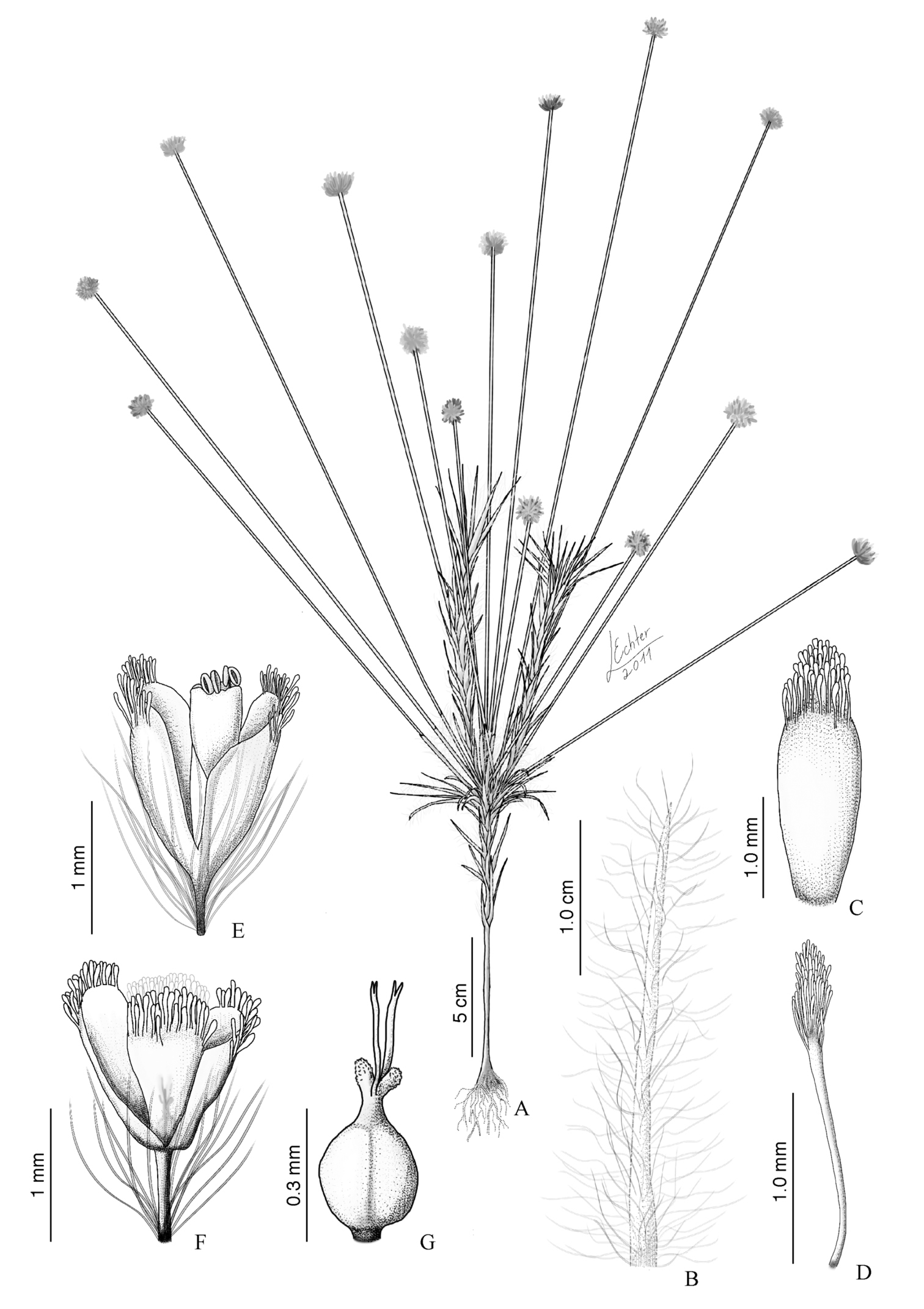






(C) 2012 Livia Echternacht. This is an open access article distributed under the terms of the Creative Commons Attribution License 3.0 (CC-BY), which permits unrestricted use, distribution, and reproduction in any medium, provided the original author and source are credited.
For reference, use of the paginated PDF or printed version of this article is recommended.
Syngonanthus weddellii var. gracilis Moldenke, (1973) was described very briefly based on a single collection. A careful analysis reveals that this variety has dimerous flowers, free petals of the pistillate flower and bifid stigmatic branches. It is therefore misplaced in Syngonanthus Ruhland (1900). We transfer it to Paepalanthus Mart. (1834) at the species level, as it is distinct from morphologically similar species: Paepalanthus flaccidus (Bong.) Koern. (1863), Paepalanthus trichophyllus (Bong.) Koern. (1863), and Paepalanthus strictus Koern. (1863). The epithet gracilis is no longer available, hence, we have coined the name Paepalanthus rectifolius. We also provide a full description, illustrations, a distribution map, and pertinent comments.
Brazil, Goiás, Nomenclature, Syngonanthus, Taxonomy
Paepalanthus Mart. (1834) is one of the largest genera of Eriocaulaceae, comprising ca. 400 species (
In the last century, Harold Norman Moldenke published hundreds of new Eriocaulaceae taxa, most of them based on the specimens of his personal herbarium, now hosted in the LL herbarium, and on the specimens deposited in the NY herbarium. Many of these descriptions are quite short, especially those from taxa below the species level. Thus, the identification of such taxa is problematic, relying obligatorily on the analysis of the type specimens. Recent analysis of these specimens leads to the conclusion that Syngonanthus weddellii var. gracilis Moldenke, (1973) is misplaced within Syngonanthus and should be considered a distinct species in Paepalanthus. In order to solve this issue, we propose the following nomenclatural changes. We also provide a full description, comments, illustrations, and a distribution map.
Taxonomyurn:lsid:ipni.org:names:77118000-1
http://species-id.net/wiki/Paepalanthus_rectifolius
Fig. 1Syngonanthus weddellii Moldenke var. gracilis Moldenke, Phytologia 25: 224. 1973. TYPE: BRAZIL. Goiás. Pirenópolis: Serra dos Pirineus, ca. 18 km E of Pirenópolis town, 1000 m alt., 15 Jan. 1972, H. S. Irwin, W. R. Anderson, M. Stieber & E. Y. Lee 34259 (holotype, LL!; isotype, NY!).
Herbs, 20–40 cm long. Aerial stem 10–20 cm long, pilose with long curled filamentous trichomes ca. 1 cm long, bearing distal inflorescences; after the flowering period, the stem elongates and ramifies distally to the inflorescences, giving rise to other inflorescences in the next fertile period. Leaves spirally disposed along the elongated stem, persistent, linear, flat, patent, 2.0–4.0 × 0.1–0.2 cm, villous in both surfaces, with pedicellate filamentous erect to curled trichomes ca. 0.7 cm long, sheath enlarged, up to 2–3 mm, semi-amplexicaul, apex acute to acuminate. Spathes 2.5–3.5 cm long, abaxial surface pubescent as the leaves, oblique opening, apex acute. Scapes 10–45 per fertile branch, 15–25 cm long, pubescent with short adpressed simple trichomes, early glabrescent. Capitula 5–8 mm diam., spherical; involucral bracts in 5–8 series, oblong, concave, ca. 3.0 × 1.0 mm, external series completely glabrous in both surfaces, internal series densely tufted and ciliated at the apex, with trichomes ca. 0.3 mm long, with clavate apical cells, golden, apex obtuse; receptacle semi-spherical, hairy. Flowers dimerous, ca. 150 per capitulum, ca. 4 times more staminates than pistillates. Floral bracts linear, flat, ca. 1.5 mm long, hairy toward the apex to glabrescent, trichomes with clavate apical cells, brown to dark, apex acute. Staminate flowers ca. 1.5–2.0 mm long, including the pedicel; pedicel ca. 0.5 mm long, with long (ca. 1 mm) trichomes; sepals navicular, ca. 1.0–1.5 mm long, hairy toward the apex, soon glabrescent, trichomes with clavate apical cells, brown to dark in the apex, cream at the base, apex truncate, membranaceous; antophore ca. 0.5 mm long, cream, membranaceous; corolla tubular, ca. 1.0 mm long, glabrous, with the same color as the sepals, membranaceous, involute after anthesis; stamens ca. 1.0 mm long, anthers white; pistillodes 2, ca. 0.1 mm long, papillose, hyaline. Pistillate flowers ca. 1.5–2.0 mm long, including the pedicel; pedicel ca. 0.5 mm long, with trichomes ca. 1 mm long; sepals navicular, ca. 1.0–1.5 mm long, hairy toward the apex, soon glabrescent, trichomes with clavate apical cells, brown to dark in the apex, cream at the base, apex truncate, membranaceous; petals free, ca. 1.0 mm long, densely pilose toward the apex, trichomes with clavate apical cells, hyaline, membranaceous; gynoecium ca. 0.5 mm long, ovary ca. 0.2 mm long, style ca. 0.2 mm, appendages ca. 0.05 mm long, hyaline, inserted at the same point of the stigmatic branches, stigmatic branches 0.2 mm long, bifid. Seeds not seen.
Paepalanthus rectifolius Trovó, Echter & Sano A Habit B Leaf detail C Involucral bract from the internal series, abaxial surface D Floral bract abaxial surface E Staminate flower F Pistillate flower G Gynoecium. Drawn from the type collection (H. S. Irwin, W. R. Anderson, M. Stieber & E. Y. Lee 34259, LL).
Syngonanthus weddellii var. gracilis Moldenke was misplaced in Syngonanthus as this taxon has truly free petals on the pistillate flower and bifid stigmatic branches. It is therefore transferred at the species level to Paepalanthus, a genus encompassing such morphological traits. The epithet gracilis , however, has been previously used in Paepalanthus by
Paepalanthus rectifolius Trovó, Echter & Sano distribution map.
The morphologically related species are Paepalanthus flaccidus (Bong.) Koern. (1863), Paepalanthus trichophyllus (Bong.) Koern. (1863), and Paepalanthus strictus Koern. (1863), three species with dimerous flowers recently excluded from Paepalanthus sect. Diphyomene Ruhland (1903) (
We would like to thank the curators of the LL and NY herbaria for access to the historical collections of Eriocaulaceae. The Alexander von Humboldt Foundation provided financial support to M. Trovó; FAPESP (proc. 08/54886-1) and CAPES to L. Echternacht; and CNPq (proc. 307100/2009-0) to P.T. Sano.

